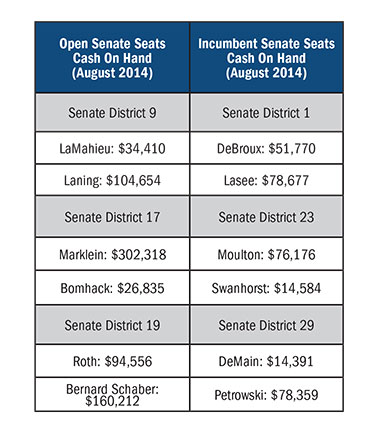Wisconsin Democrats believe they have a legitimate shot at recapturing the state Senate on November 4. Their goal in 2014 is to flip the state Senate from red to blue and, in turn, stop Gov. Scott Walker and his allies in the legislature from passing legislation Democrats believe is detrimental to public education, the environment and middle-class working families.
Today, Republicans control the state Senate 18-15, so Democrats need a net gain of three seats to recapture the Upper House. Most insiders and political handicappers believe it’s a steep hill to climb for Senate Democrats, but Senate minority leader Chris Larson thinks it’s very possible: “Because of the strong grassroots support from families and communities throughout every corner of the state, Democrats are poised to become the majority party in the Wisconsin State Senate,” he said in a press release on August 12.
To achieve their goal, Democrats have targeted six state Senate seats they believe will provide the best chance for a net three-seat pickup. In the 2010 midterm elections, Gov. Walker carried all six targeted seats; in 2012, President Obama carried only two of the six. On the numbers alone, it appears to be a difficult task to flip three seats on this list. Wisconsin Democrats, though, will have help from their labor allies in this effort. National and state labor strategists have targeted several states with competitive gubernatorial races — including Wisconsin — as well as five state legislative chambers for flipping from Republican to Democratic control. The Wisconsin State Senate is on this list. The following page provides a brief look at the six targeted districts.
|
SENATE DISTRICT 1
- Obama 2012: 47%
- Romney 2012: 52%
- Walker 2010: 57%
- Barrett 2010: 43%
- Classification: Lean GOP
|
 |
|
SENATE DISTRICT 9
- Obama 2012: 46%
- Romney 2012: 53%
- Walker 2010: 63%
- Barrett 2010: 37%
- Classification: Strong GOP
|
 |
|
SENATE DISTRICT 17
- Obama 2012: 57%
- Romney 2012: 42%
- Walker 2010: 53%
- Barrett 2010: 47%
- Classification: Lean Dem
|
 |
SENATE DISTRICT 19
- Obama 2012: 49%
- Romney 2012: 49%
- Walker 2010: 56%
- Barrett 2010: 44%
- Classification: Lean GOP
|

|
SENATE DISTRICT 23
- Obama 2012: 48%
- Romney 2012: 51%
- Walker 2010: 58%
- Barrett 2010: 42%
- Classification: Swing
|
 |
SENATE DISTRICT 29
- Obama 2012: 47%
- Romney 2012: 52%
- Walker 2010: 58%
- Barrett 2010: 42%
- Classification: Lean GOP
|
 |
Can Democrats capture the state Senate?
2014 election trends: The November 4 election is shaping up as a fairly typical midterm election cycle, which usually means the party holding the White House has a bad night. The 2014 election will be the second Obama midterm, and his job approval number of 43 percent is well below the all-important 50 percent threshold. When presidential job approval numbers are underwater, the president’s party loses seats in Congress and state legislatures. Senate Democrats will struggle with Obama’s low approval ratings in Wisconsin.
Midterm voter turnout: In presidential elections, voter turnout is about 70 percent in Wisconsin; in midterm elections, turnout is between 45 and 50 percent. The 2014 midterm voting population will be smaller, older and less diverse than the 2012 presidential election cycle. In the 2010 midterms, Scott Walker carried all six targeted seats with a low-end performance of 53 percent and a high-end performance of 63 percent. In the 2012 presidential cycle, Barack Obama carried only two of the target seats with 57 percent (Sen. Schultz in the 17th District) and 49 percent (Sen. Ellis in the 19th District). The 2014 elections will be closer to the 2010 midterm elections than the 2012 presidential elections.
Open seats vs. incumbents: Three open seats (9th, 17th and 19th districts) are on the target list along with three seats with incumbents running for re-election (1st, 23rd and 29th districts). Generally, it’s easier to flip a competitive legislative district from one party to the other in open seats, and Republicans have three open seats on the Democrats’ target list. Conversely, it’s more difficult to defeat an incumbent running for re-election unless the incumbent has said or done something to complicate a re-election bid. The open seat factor is perhaps the single best reason Democrats have a slight chance to win back the state Senate.
Fundraising numbers: Fundraising is usually an advantage for incumbents running for re-election as well as for candidates who enter a race earlier in the election cycle than their opponents. And for the first half of 2014, this is the case in the six target districts: the three incumbents running for re-election have significant cash advantages over their opponents, while the three open seats show the “early to the race” candidate significantly ahead of the opposition.

Joe Murray is Director of Political and Governmental Affairs for the WRA.